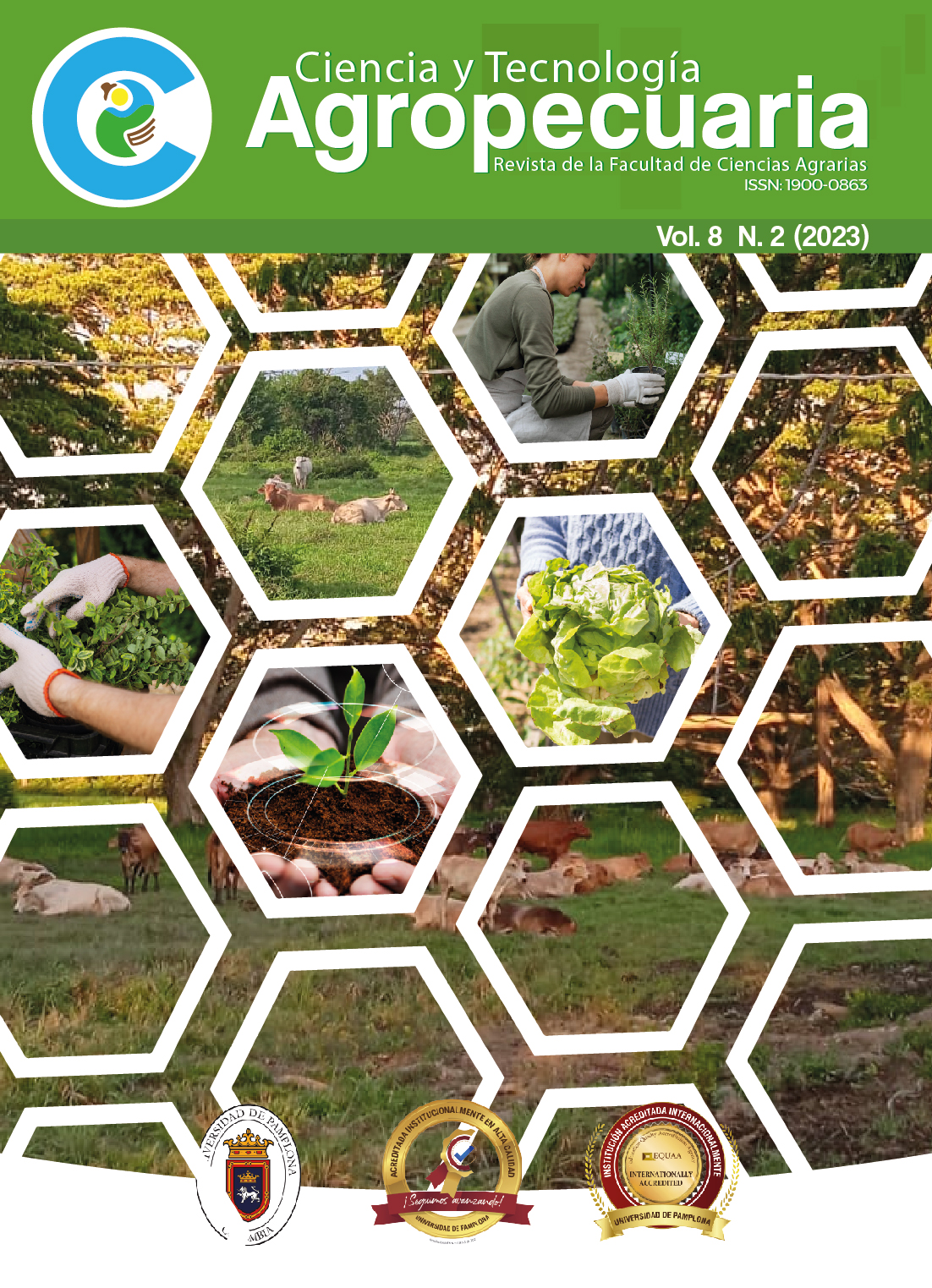Aspectos epidemiológicos de la hernia de la col en tres especies de crucíferas en el Huerto de la Escuela Normal Superior de Pamplona, Norte de Santander
DOI:
https://doi.org/10.24054/cyta.v8i2.2895Palabras clave:
signo, síntoma, severidad, incidencia, enfermedad, regresiónResumen
El objetivo de la investigación fue caracterizar, cuantificar y determinar la incidencia y la severidad de esta enfermedad hernia de las crucíferas causada por Plasmodiophora brassicae Woronin en comparación con la edad de los cultivos, el pH del suelo y la pendiente del terreno. Se realizaron muestreos periódicos en las tres crucíferas repollo, brócoli y coliflor y se recopilaron datos foliares y radiculares de la incidencia y la severidad de la enfermedad. Por medio de datos y analizando el comportamiento en campo de las plantas afectadas se observó que el repollo presentó la mayor incidencia y severidad de la enfermedad, según los datos del Área Bajo la Curva de Progreso de la Enfermedad (ABCPE) en los dos tipos de pendientes (pendiente alta y pendiente baja). También se observó que el pH influyó en la incidencia de la enfermedad en repollo por encima de pH 7 a pesar de no encontrarse diferencia significativa. Tampoco hubo diferencia significativa entre las especies de cultivos, sin embargo, se observó una tendencia a ser mayor la incidencia y severidad de la enfermedad en las parcelas ubicadas en zonas de poca pendiente y donde se acumulaba más fácilmente el agua.
Descargas
Referencias
Agrios, G. (2005). Plant Pathology. Elsevier Academic Press.
Campbell, C., & Madden, L. (1990). Introduction to Plant Disease Epidemiology. John Wiley and Sons Inc.
Castellanos González, L., Fuentes Rodríguez, Y., & Villamizar Valencia, C. J. (2022). Biological alternatives combined with Naphthaleneacetic Acid (NA) for the management of Plasmodiophora brassicae Woronin in cauliflower (Brassica oleracea L. var. Botrytis). INGE CUC, 18(1), 1-14.
Castellanos, L., Martínez, G., Castro, M., & Villamizar, C. (2019a). Alternativas para el control de la hernia de las crucíferas en brócoli en el municipio Mutiscua, provincia de Pamplona, Norte de Santander. Ciencia y Tecnología Agropecuaria, 4(2), 75-81. https://ojs.unipamplona.edu.co/index.php/rcyta/article/view/1014/1124
Castellanos-González, L., Fuentes, Y. Y., & Mondragón, Y. D. (2019b). Comparación de la eficacia de tres antagonistas comerciales para el control de Plasmodiophora brassicae Wororin en condiciones de laboratorio. Ciencia y Tecnología Agropecuaria, 4(1), 22-28. https://ojs.unipamplona.edu.co/index.php/rcyta/article/view/903/1107
Ciba Geygi. (1981). Manual de ensayos de campo en producción vegetal (2a ed.). Basilea, Suiza:
Donald, E. C., Lawrence, J. M., & Porter, I. J. (2004). Influence of particle size and application method on the efficacy of calcium cyanamide for control of clubroot of vegetable brassicas. Crop Protection, 23(4), 297-303.
Heinrich, A., & Stone, A. (2014). Clubroot (Plasmodiophora brassicae) control strategies on brassicas: Oregon Processed Vegetable Commission Continuing Project Report, 2014. Recuperado de https://scholar.google.es/scholar?hl=es&as_sdt=0%2C5&q=Heinrich%2C+A.%2C+%26+Stone%2C+A.+%282014%29.+&btnG=
ICA. (2012). Manejo fitosanitario del cultivo de hortalizas, medidas para la temporada invernal. Bogotá: Camilo Ernesto Vásquez Gonzáles. Recuperado el 27 de agosto de 2018, de https://www.ica.gov.co/getattachment/bb883b42-80da-4ae5-851f-4db05edf581b/Manejo-fitosanitario-del-cultivo-de-hortalizas.aspx.
Niwa, R., Kumei, T., Nomura, Y., Yoshida, S., Osaki, M., & Ezawa, T. (2007). Increase in soil pH due to Ca-rich organic matter application causes suppression of the clubroot disease of crucifers. Soil Biology & Biochemistry, 39(3), 778-785.
Padilla Huertas, F. L. (2020). Caracterización de los factores de riesgo asociados a la hernia de las crucíferas en los sistemas de producción de hortalizas en Colombia (Doctoral dissertation, Universidad Nacional de Colombia).
Pengjie, H., Wenyan, C., Shahzad, M., Xingyu, L., Yixin, W., Xumang, Y., & Yueqiu, H. (2019). Plasmodiophora brassicae root hair interaction and control by Bacillus subtilis XF-1 in Chinese cabbage. Obtenido de https://www.sciencedirect.com/science/article/pii/S1049964418304456#!
Strelkov, S. E., Tewari, J. P., & Smith-Degenhardt, E. (2006). Characterization of Plasmodiophora brassicae populations from Alberta, Canada. Canadian Journal of Plant Pathology, 28, 467–474.
Descargas
Publicado
Número
Sección
Licencia
Derechos de autor 2023 Claudia Lisec Gamboa Bautista, Leonides Castellanos Gonzalez

Esta obra está bajo una licencia internacional Creative Commons Atribución-NoComercial-CompartirIgual 4.0.










